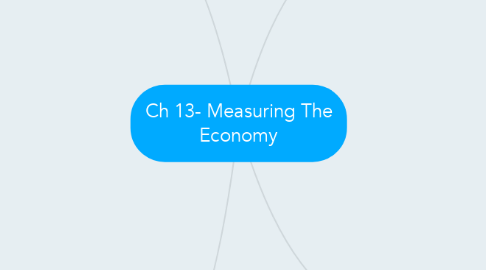Ch 13- Measuring The Economy
by KATELYN BLUE

1. 13.2- How Do Economists Measure The Size Of The Economy?
1.1. Gross Domestic Product is the main way to measure a nation's economy.
1.2. The market value is the price that consumers are willing to pay for a product. This helps the Bureau of Economic Analysis determine what market value to put on products and helps measure the economy.
1.3. The final goods and services are also another key factor in measuring the nations economy. The final good, such as a box of cereal, are included in the GDP, whereas intermediate goods or, the wheat they used to produce the cereal, are not included.
1.4. Nominal GDP- a measure of a country's economic output measured in current dollars. This does not reflect on inflation.
1.5. Per Capita GDP- a nation's real GDP divided by the total population
2. 13.3- What Does The Unemployment Rate Tell Us About An Economy's Health?
2.1. The Bureau of Labor Statistics reports the total number of people who are unemployed each month. The BLS totals the number of people who are employed and who are unemployed each month by taking a random sample.
2.2. There are four types of unemployment. Frictional, structural, seasonal, and cyclical. The "best' unemployment would be frictional, for you are between jobs.
2.3. There are some problems with calculating the unemployment rate, such as people who decide to stop looking for work. They also do not include involuntary part-time work in the unemployment rate. There are also people who make their living off of drug dealing and other illegal things, this is not calculated into unemployment.
2.4. Unemployment Rate- percentage of the labor force who is not employed, but actively seeking work.
2.5. Discouraged Workers- unemployed people who have stopped looking for work.
3. 13.4- What Does The Inflation Rate Reveal About An Economy's Health?
3.1. What is inflation rate? Inflation rate is the percent increase in the average price of goods. Inflation is generally not a good thing, because it basically means you can't buy as much with your dollar.
3.2. There are three different kinds of inflation. Creeping, hyper, and deflation. Creeping inflation isn't necessarily good or bad, it's just the slight increase in the average price. Creeping inflation is expected. Hyperinflation is an extreme jump of inflation. No one is expecting this, making it hard to deal with. Deflation is a decrease in the price of goods; good for the consumer, can be detrimental to a business.
3.3. Some economic costs of inflation include: loss of purchasing power, higher interest rates, and loss of economic efficiency. Although an inefficient economy doesn't benefit anyone, inflation can be very good for a business owner.
3.4. Consumer Price Index- CPI is a measure of the cost of living usually from year to year
3.5. deflationary spiral- a downward trend in prices, wages, and business activity.
3.6. http://www.wsj.com/articles/inflation-is-low-but-u-s-consumers-still-feel-a-pinch-1436727650
3.7. This article talks about how the inflation rate affects Americans each year. The inflation rate has been low each year, being about 2%.
4. 13.5- How Does The Business Cycle Relate To Economic Health?
4.1. There are four stages in the business cycle. Expansion, peak, contraction, trough. First, there is expansion of the economy which leads to a peak. Once you hit a peak, you can't go any higher, so you start to go down, or contract. Once you hit the lowest part of contraction, or the trough, expansion starts all over again.
4.2. There are some economic indicators of a business cycle. There are leading indicators which measures the rise and fall of the economy. Coincident indicators are things such as GDP. Lagging indicators include things like unemployment.
4.3. Some people call the business cycle the bust to boom. The bust is the bad period of the economy, where the boom is where the economy is healthy and growing. Business investments helps grow the economy, for it provides more jobs which promote more consumer spending.
4.4. Recession- decline in national economic activity
4.5. Depression- prolonged economic downturn characterized by plunging real GDP and high unemployment


